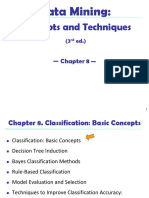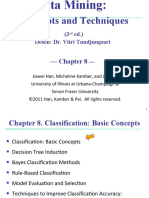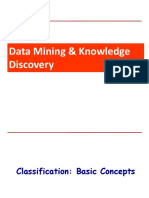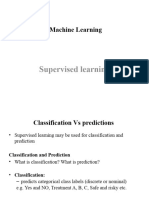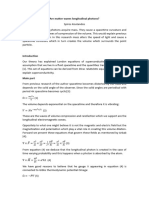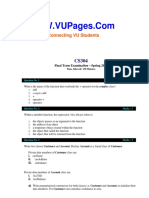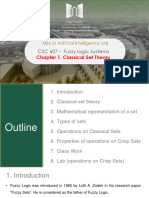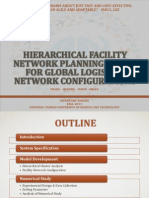1
Datamining & Warehousing
Unit 3 – Decision Tree
Dr.VIDHYA B
ASSISTANT PROFESSOR & HEAD
Department of Computer Technology
Sri Ramakrishna College of Arts and Science
Coimbatore - 641 006
Tamil Nadu, India
Chapter 8. Classification: Basic
Concepts
Classification: Basic Concepts
Decision Tree Induction
Bayes Classification Methods
Rule-Based Classification
Model Evaluation and Selection
Techniques to Improve Classification Accuracy:
Ensemble Methods
Summary
2
Decision Tree Induction: An
Example
age income student credit_rating buys_computer
<=30 high no fair no
Training data set: Buys_computer <=30 high no excellent no
The data set follows an example of 31…40 high no fair yes
>40 medium no fair yes
Quinlan’s ID3 (Playing Tennis) >40 low yes fair yes
Resulting tree: >40 low yes excellent no
31…40 low yes excellent yes
age? <=30 medium no fair no
<=30 low yes fair yes
>40 medium yes fair yes
<=30 medium yes excellent yes
<=30 overcast
31..40 >40 31…40 medium no excellent yes
31…40 high yes fair yes
>40 medium no excellent no
student? yes credit rating?
no yes excellent fair
no yes no yes
3
Algorithm for Decision Tree
Induction
Basic algorithm (a greedy algorithm)
Tree is constructed in a top-down recursive divide-and-
conquer manner
At start, all the training examples are at the root
Attributes are categorical (if continuous-valued, they are
discretized in advance)
Examples are partitioned recursively based on selected
attributes
Test attributes are selected on the basis of a heuristic or
statistical measure (e.g., information gain)
Conditions for stopping partitioning
All samples for a given node belong to the same class
There are no remaining attributes for further partitioning –
majority voting is employed for classifying the leaf
There are no samples left
4
Brief Review of Entropy
m=2
5
Attribute Selection Measure:
Information Gain (ID3/C4.5)
Select the attribute with the highest information gain
Let pi be the probability that an arbitrary tuple in D belongs to
class Ci, estimated by |Ci, D|/|D|
Expected information (entropy) needed to classify
m a tuple in D:
Info( D) pi log 2 ( pi )
i 1
Information needed (after using A to split D into v partitions) to
v | D |
classify D:
Info A ( D )
j
Info( D j )
j 1 | D |
Information gained by branching on attribute A
Gain(A) Info(D) Info A(D)
6
Attribute Selection: Information
Gain
Class P: buys_computer = “yes” 5 4
Infoage ( D ) I (2,3) I (4,0)
Class N: buys_computer = “no” 14 14
9 9 5 5 5
Info( D) I (9,5) log 2 ( ) log 2 ( ) 0.940 I (3,2) 0.694
14 14 14 14 14
age pi ni I(p i, n i) 5
<=30 2 3 0.971 I (2,3)means “age <=30” has 5 out of
14
31…40 4 0 0 14 samples, with 2 yes’es and 3
>40 3 2 0.971 no’s. Hence
age
<=30
income student credit_rating
high no fair
buys_computer
no
Gain(age) Info( D ) Infoage ( D ) 0.246
<=30 high no excellent no
31…40 high no fair yes
>40 medium no fair yes Similarly,
>40 low yes fair yes
>40 low yes excellent no
31…40 low yes excellent yes Gain(income) 0.029
<=30 medium no fair no
<=30
>40
low
medium
yes
yes
fair
fair
yes
yes
Gain( student ) 0.151
<=30
31…40
medium
medium
yes
no
excellent
excellent
yes
yes Gain(credit _ rating ) 0.048
31…40 high yes fair yes
>40 medium no excellent no 7
for Continuous-Valued
Attributes
Let attribute A be a continuous-valued attribute
Must determine the best split point for A
Sort the value A in increasing order
Typically, the midpoint between each pair of adjacent values
is considered as a possible split point
(ai+ai+1)/2 is the midpoint between the values of ai and ai+1
The point with the minimum expected information
requirement for A is selected as the split-point for A
Split:
D1 is the set of tuples in D satisfying A ≤ split-point, and D2 is
the set of tuples in D satisfying A > split-point
8
Gain Ratio for Attribute
Selection (C4.5)
Information gain measure is biased towards attributes with a
large number of values
C4.5 (a successor of ID3) uses gain ratio to overcome the
problem (normalization to information gain)
v | Dj | | Dj |
SplitInfo A ( D) log 2 ( )
j 1 |D| |D|
GainRatio(A) = Gain(A)/SplitInfo(A)
Ex.
gain_ratio(income) = 0.029/1.557 = 0.019
The attribute with the maximum gain ratio is selected as the
splitting attribute
9
Gini Index (CART, IBM
IntelligentMiner)
If a data set D contains examples from n classes, gini index, gini(D)
is defined as n 2
gini( D) 1 p j
j 1
where pj is the relative frequency of class j in D
If a data set D is split on A into two subsets D1 and D2, the gini
index gini(D) is defined as |D | |D |
gini A ( D) 1 gini( D1) 2 gini( D 2)
|D| |D|
Reduction in Impurity:
gini( A) gini( D) giniA ( D)
The attribute provides the smallest ginisplit(D) (or the largest
reduction in impurity) is chosen to split the node (need to
enumerate all the possible splitting points for each attribute)
10
Computation of Gini Index
Ex. D has 9 tuples in buys_computer = “yes”
2
and
2
5 in “no”
9 5
gini ( D) 1 0.459
14 14
Suppose the attribute income partitions D into 10 in D1: {low,
10 4
medium} and 4 in D2 giniincome{low,medium} ( D) 14 Gini( D1 ) 14 Gini( D2 )
Gini{low,high} is 0.458; Gini{medium,high} is 0.450. Thus, split on the
{low,medium} (and {high}) since it has the lowest Gini index
All attributes are assumed continuous-valued
May need other tools, e.g., clustering, to get the possible split
values
11
Comparing Attribute Selection
Measures
The three measures, in general, return good results but
Information gain:
biased towards multivalued attributes
Gain ratio:
tends to prefer unbalanced splits in which one partition is
much smaller than the others
Gini index:
biased to multivalued attributes
has difficulty when # of classes is large
tends to favor tests that result in equal-sized partitions
and purity in both partitions
12
Other Attribute Selection
Measures
CHAID: a popular decision tree algorithm, measure based on χ2 test for
independence
C-SEP: performs better than info. gain and gini index in certain cases
G-statistic: has a close approximation to χ2 distribution
MDL (Minimal Description Length) principle (i.e., the simplest solution is
preferred):
The best tree as the one that requires the fewest # of bits to both (1)
encode the tree, and (2) encode the exceptions to the tree
Multivariate splits (partition based on multiple variable combinations)
CART: finds multivariate splits based on a linear comb. of attrs.
Which attribute selection measure is the best?
Most give good results, none is significantly superior than others
13
Overfitting and Tree Pruning
Overfitting: An induced tree may overfit the training data
Too many branches, some may reflect anomalies due to
noise or outliers
Poor accuracy for unseen samples
Two approaches to avoid overfitting
Prepruning: Halt tree construction early ̵ do not split a node
if this would result in the goodness measure falling below a
threshold
Difficult to choose an appropriate threshold
Postpruning: Remove branches from a “fully grown” tree—
get a sequence of progressively pruned trees
Use a set of data different from the training data to
decide which is the “best pruned tree” 14
Enhancements to Basic Decision Tree
Induction
Allow for continuous-valued attributes
Dynamically define new discrete-valued attributes that
partition the continuous attribute value into a discrete set of
intervals
Handle missing attribute values
Assign the most common value of the attribute
Assign probability to each of the possible values
Attribute construction
Create new attributes based on existing ones that are
sparsely represented
This reduces fragmentation, repetition, and replication
15
Classification in Large Databases
Classification—a classical problem extensively studied by
statisticians and machine learning researchers
Scalability: Classifying data sets with millions of examples and
hundreds of attributes with reasonable speed
Why is decision tree induction popular?
relatively faster learning speed (than other classification
methods)
convertible to simple and easy to understand classification
rules
can use SQL queries for accessing databases
comparable classification accuracy with other methods
RainForest (VLDB’98 — Gehrke, Ramakrishnan & Ganti)
Builds an AVC-list (attribute, value, class label)
16
Scalability Framework for
RainForest
Separates the scalability aspects from the criteria that
determine the quality of the tree
Builds an AVC-list: AVC (Attribute, Value, Class_label)
AVC-set (of an attribute X )
Projection of training dataset onto the attribute X and
class label where counts of individual class label are
aggregated
AVC-group (of a node n )
Set of AVC-sets of all predictor attributes at the node n
17
Rainforest: Training Set and Its
AVC Sets
Training Examples AVC-set on Age AVC-set on income
age income studentcredit_rating
buys_computerAge Buy_Computer income Buy_Computer
<=30 high no fair no yes no
yes no
<=30 high no excellent no
high 2 2
31…40 high no fair yes <=30 2 3
31..40 4 0 medium 4 2
>40 medium no fair yes
>40 low yes fair yes >40 3 2 low 3 1
>40 low yes excellent no
31…40 low yes excellent yes
AVC-set on
<=30 medium no fair no AVC-set on Student
credit_rating
<=30 low yes fair yes
student Buy_Computer Buy_Computer
>40 medium yes fair yes
Credit
<=30 medium yes excellent yes yes no
rating yes no
31…40 medium no excellent yes yes 6 1 fair 6 2
31…40 high yes fair yes no 3 4 excellent 3 3
>40 medium no excellent no
18
Optimistic Algorithm for Tree
Construction)
Use a statistical technique called bootstrapping to create
several smaller samples (subsets), each fits in memory
Each subset is used to create a tree, resulting in several
trees
These trees are examined and used to construct a new
tree T’
It turns out that T’ is very close to the tree that would
be generated using the whole data set together
Adv: requires only two scans of DB, an incremental alg.
19
Presentation of Classification
Results
February 28, 2025 Data Mining: Concepts and Techniques 20
SGI/MineSet 3.0
February 28, 2025 Data Mining: Concepts and Techniques 21
Perception-Based Classification
(PBC)
Data Mining: Concepts and Techniques 22

















